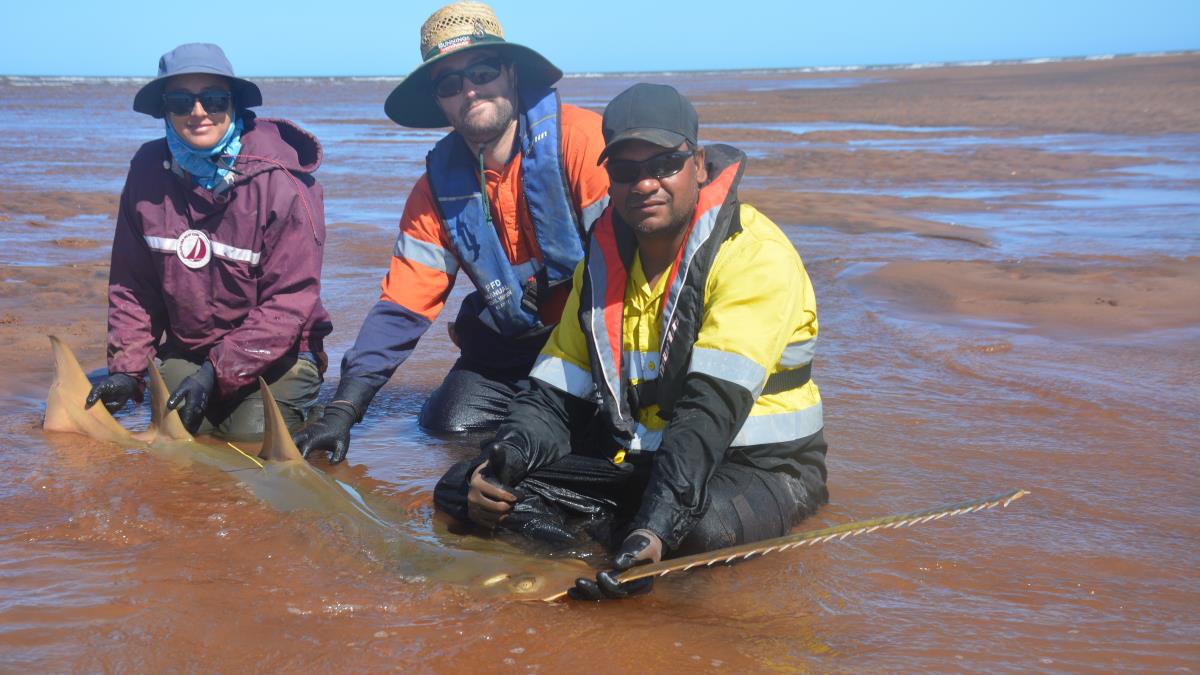Researchers studying a critically endangered sawfish have discovered key breeding information that highlights the urgent need to conserve critical nursery sites in Western Australia (WA).
The green sawfish (Pristis zijsron) is one of the largest fishes on Earth, growing to more than 6 metres long. It is a type of ray known for its iconic saw-like snout, or rostrum, and is found in tropical and subtropical waters of the Indo-West Pacific.
The species has become critically endangered due to habitat loss and illegal trade for its fins and elongated rostra, which become easily entangled in fishing gear.
One of the greatest barriers to effective conservation of green sawfish is how little is known about its reproductive biology, genealogical relationships and incidence of inbreeding.
To address this gap, a new Australian study investigated the species’ genetics at a key nursery area – the estuarine waters of the Ashburton River Delta and adjacent tidal creeks in the southern Pilbara region of WA, more than 1,000km north of Perth.
Researchers investigated the kinship of more than 100 green sawfish using DNA samples collected between 2011 and 2022. They found that more than 50 females had given birth in that time, 9 of which had used the area as a birth site on multiple occasions.
“These findings are really important for informing conservation efforts, as they demonstrate that some female green sawfish are actually returning to, and reusing, the same site for pupping,” says Dr Jack Ingelbrech from the Centre for Sustainable Aquatic Ecosystems at Murdoch University, who co-led the research published in Aquatic Conservation: Marine and Freshwater Ecosystems.
Green sawfish across the study area are also highly related, with high proportions of both maternal and paternal half-siblings. At least 88% of all sampled sawfish were related to at least one other individual by up to the third-degree.
The findings provide important insights into the reproductive phenomenon of “philopatry” for both females and males.
“This is where individuals of one sex are more prone to returning to their birthplace for reproduction, whereas members of the opposite sex are prone to disperse,” says Ingelbrecht.
“The presence of so many maternal and paternal half-siblings suggests that dispersal is limited in both female and male green sawfish.”
The researchers say that protecting key nursery sites may be one of the most effective methods of safeguarding P. zijsron and should be a high priority in conservation efforts.
“If the population in the Ashburton River and adjacent tidal creeks declines or experiences localised extinction, there is a risk that it may not be replenished by individuals from other populations over short timescales,” they write.
“The southern Pilbara region is facing rapid industrial development, which threatens the stability of this coastal ecosystem. It is therefore imperative to better understand the ecology of P. zijsron, to identify and mitigate threats to this species and establish more effective management strategies.”














/https://tf-cmsv2-smithsonianmag-media.s3.amazonaws.com/filer_public/34/31/3431771d-41e2-4f97-aed2-c5f1df5295da/gettyimages-1441066266_web.jpg)






Discussion about this post